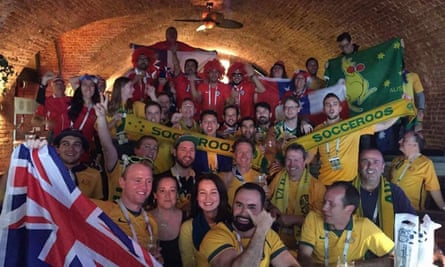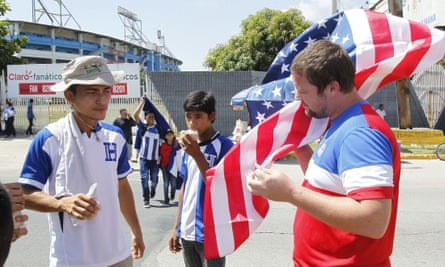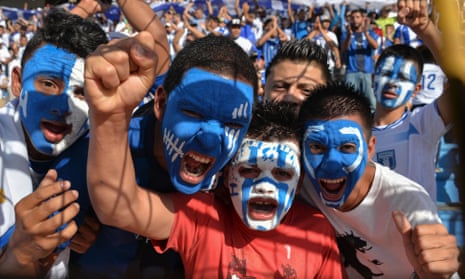Twelve hours after the Socceroos beat Syria, across 120 nervous, suffering minutes in Sydney, Romell Quioto beat the offside trap. To the delight of 38,000 Hondurans in the Estadio Olimpico Metropolitano, he spun a neat full circle, picked his spot, and unlocked a series of events that would send a handful of Socceroos fans on a 14,000km trip from Australia to San Pedro Sula.
It could have been Panama. Or the United States. Kevin Pollard, a travel booker from Melbourne, and his fellow travelling Socceroos fans had done the maths – the points, the permutations of the results and the airfares. Honduras, the small Central American country, population 9 million, were the outsiders.
But if decades of supporting the Socceroos had taught them anything it was to expect the unexpected.
Pollard and his fellow fan Les Street, a self-confessed tragic writing a history of Australian football stadiums, are two of roughly 300 fans travelling to Honduras for this week’s first leg of the Socceroos’ final World Cup qualifying playoff. If the current numbers hold steady, they will be outnumbered by about 120 to one.
Street says he saw all this coming – in a dream. “I’ve actually had two dreams about the Socceroos in Honduras,” he says. He went to bed on the night of the Syria game, his mind on Panama, and instead dreamt of booking tickets to Honduras, where, thanks to dream logic, he found himself playing baseball.
In the lead-up to Friday’s game (Saturday AEDT), much of the media focus has been on the gangsters and gun crime of San Pedro Sula. It has been reported as a place of Zika virus, hurricanes and carjackings – with world’s third-highest per capita murder rate.
But Pollard, and local journalists, say the only source of danger to Australian fans is Honduran anger at this relentless caricature of a country that has, at least for travelling football fans, always been safe harbour.

Pollard is leading the contingent from the Green and Gold Army, a fan group that have followed the Socceroos overseas since 2001. They’ve been to Kazakhstan, Kyrgyzstan, Iran, Tajikistan, Malaysia, Japan, Saudi Arabia and the United Arab Emirates.
This will be his 50th tour, the latest in a long-running tradition of away legs, especially for older fans, who grew up before the glory days of three successive World Cups and the (notionally) easier path of direct qualification via the Asian confederation.
“We have fans who have been on a lifetime journey with the Socceroos,” says Michael Edgley, a director of the Green and Gold Army. His love of away matches began when he watched Australia beat England 3-1 in a 2000 friendly at Upton Park, West Ham United’s old stadium in London. “We have all generations of fans. They’ve gone to Scotland in 1985, they’ve flown to Argentina in 1993.”
This kind of far-flung, cross-confederation travel, is in many ways a part of the DNA of a Socceroos fan. From 1997’s 1-1 with Iran in Tehran, to the 3-0 humbling in Montevideo in 2001, to have been a fan is to have lived, for too long, on a diet entirely of odd intercontinental trips ending in heartbreak.
And this will probably be the last time. With the World Cup expanding in 2026 to 48 teams, Australia might never have to endure a playoff again. The travellers to Honduras are saying farewell to a unique kind of Antipodean, self-doubting rite of passage – of white-knuckle, absolute drama, constant fear of disaster, and the mad mathematics of away goals always in the back of the mind.
In Honduras, the Estadio Olimpico Metropolitano is sold out, with 38,000 fans booked in and extra overfill very much expected. The Australians anticipate an atmosphere to make the trip worth it.
“Honduras is a country that lives for football, dreams of football, eats football,” says Gerson Gómez, a Honduran journalist and football writer. “People arrive very early at the stadium. The temperature is usually 100 degrees Fahrenheit, yet the Honduran fanatics enter under a strong sun two or three hours before the match begins.
“There is no violence, no punches, no hooligans. When the Honduras national team plays, people behave well. Inside the stadium, people drink beer and shout, sing, jump. We have a saying: when the national team plays, we are all joined.”
Gómez points out that travelling fans from the United States, Argentina, Costa Rica, and even fierce rivals Mexico have all visited here during qualifying without incident.
“I do not deny that there are problems, that there is organised violence, that there are criminals, but the vast majority of Hondurans are honest and hard-working people,” he says. “Honduras is a country with high rates of violence, but it doesn’t affect a match of World Cup qualification.”
Inside the stadium, the Honduran fans bring drums and trumpets. “I don’t know how we’re going to compete with that if there’s only 300 of us,” says Pollard. “But hopefully the team, knowing there’s 400 Australians there, they’ll feel pretty pumped up.
“You’d feel pretty proud that there are all these other Aussies there. They know it’s a fair way to go. That we made an effort. It’ll help a fair amount.”

The Hondurans too, will put everything on the line. “Going to the World Cup is the greatest joy that Hondurans can have every four years,” says Gómez. “When the national team plays, the cities stop. The traffic is over. The radios play commentary, the televisions only project the game.”
But for now, the Australian fans are looking forward to immersing themselves in Honduran culture. Street has been there for a full week. The Green and Gold Army have a six-day itinerary planned that takes them to San Pedro Sula’s cathedral, its markets, and the Cafe Skandia – a 1950s-style cafe that looks like an ocean liner.
Street is also planning on visiting the Copan Ruins, a Mayan archeological site three or four hours from San Pedro Sula. “I’ve never seen Mayan ruins before, so I’m really excited about that”, he says. On Thursday night, he and the other Australian fans will watch a local league game.
If, in the cauldron of the Estadio Olimpico Metropolitano, and in Sydney next week , everything goes well, the Green and Gold Army will be ready. Pollard has visited Russia multiple times already, laying down the groundwork for a huge trip for the World Cup.
They will continue travelling. “We pride ourselves on being at every single Socceroos World Cup qualifying fixture away from Australia,” says Edgley. “My favourite destination is Tokyo, and the rivalry between Australia and Japan. It’s a friendly rivalry, the Japanese fans are the most welcoming in the world. I never get tired of taking people there for the first time. It’s an amazing experience to see Saitama full of the Samurai Blue.”
Street has his eyes on central Asia. “I have a big interest now in the ex-Soviet Union,’ he says. “I started learning a bit of Russian before I went to the Confederations Cup. I don’t have a long bucket list but one of them is going to every state in the ex-Soviet Union. That’s why I was a bit disappointed that Syria got through instead of Uzbekistan. They got a goal with two minutes left. I would have preferred to go to Uzbekistan.
“I enjoy the away games more than the home ones,” he says. “You’re in another country, you bond with other people. I like talking to locals. If anyone from Honduras reads this, get in contact via Twitter and have a beer.”

Comments (…)
Sign in or create your Guardian account to join the discussion